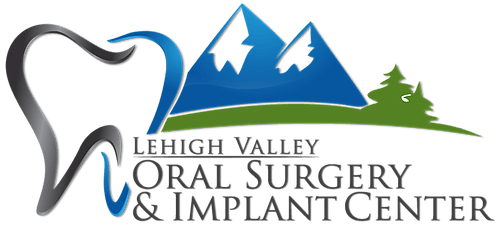Bone Augmentation Procedure for Dental Implants
Considering dental implants to restore your smile and regain optimal oral function? At Lehigh Valley Oral Surgery and Implant Center, we understand the importance of a strong foundation for long-lasting implant success. Dr. Ahmad Chaudhry, a skilled oral surgeon in Stroudsburg and Bethlehem, PA, offers bone grafting procedures to ensure your dental implants have a healthy platform for growth.
Call 484-821-1357 to learn more and schedule your dental implant consultation.
What is Dental Bone Grafting?

The bone grafting procedure involves placing bone material in the deficient area of your jaw. This material can come from various sources:
- Autograft: This is the preferred option, using your own bone harvested from another area in your body, such as the chin, hip, or tibia.
- Allograft: Bone from a human donor bank, carefully screened and processed for safety.
- Xenograft: Bone harvested from an animal source, typically cow bone.
- Alloplast: Synthetic bone substitutes made from biocompatible materials.
Once placed in the jaw, the bone graft material acts as a scaffold, promoting new bone growth and integration with existing bone tissue. This creates a stronger, more stable foundation for dental implants or other procedures.
Benefits of Bone Grafts
Dental bone grafting offers several advantages for your oral health and the success of future dental treatments:
- Enhanced Implant Success Rate: By providing a robust and voluminous jawbone, bone grafting increases the stability and osseointegration (fusion with bone) of dental implants. This significantly improves the long-term success rate of implants and reduces the risk of implant failure.
- Improved Aesthetics: Bone loss can cause the facial contours to cave in, giving a sunken appearance. Bone grafting helps preserve the natural structure of your face, leading to a more aesthetically pleasing outcome, especially when combined with dental implants.
- Functional Restoration: Sufficient bone structure allows optimal implant placement, ensuring proper chewing function and clear speech. This improves your quality of life and ability to enjoy a variety of foods.
- Preserve Natural Teeth: In some cases, bone grafting can support and save a weakened tooth by filling in bone loss around its root.
Candidacy for Bone Grafts

- Extent of Bone Loss: The amount of bone deficiency will determine the type and complexity of the grafting procedure needed.
- Location of Bone Loss: The location of bone loss in your jaw will influence the grafting technique.
- Overall Health: Underlying medical conditions or a weakened immune system might require special considerations for bone grafting.
- Dental Implant Plans: If you’re considering dental implants, bone grafting might be necessary to create a suitable foundation for their placement.
Dr. Chaudhry will conduct a thorough dental examination, including X-rays or CT scans, to assess your jawbone health and determine if bone grafting is necessary. He’ll discuss all available treatment options and answer any questions you may have to help you make an informed decision.
The Bone Grafting Procedure
Before Your Procedure:
- Consultation: Dr. Chaudhry will discuss your medical history, dental needs, and expectations during a comprehensive consultation. He’ll perform a thorough oral examination and review X-rays or CT scans to assess your jawbone health.
- Treatment Plan: Based on the evaluation, Dr. Chaudhry will develop a personalized treatment plan outlining the type of bone graft, anesthesia options, and post-operative care instructions.
- Anesthesia: Local anesthesia is typically used to numb the area around the surgical site. In some cases, sedation dentistry might be offered to promote relaxation during the procedure.
The Day of Your Procedure:
- Arrival: You’ll arrive at the dental office or surgical center and be prepped for the procedure.
- Anesthesia Administration: Local anesthesia or sedation will be administered according to your treatment plan.
- Incision: A small incision will be made in the gum tissue to expose the underlying jawbone.
- Bone Preparation: The deficient area of the jawbone will be carefully prepared to receive the grafting material. This might involve removing diseased tissue or shaping the bone for optimal graft placement.
- Graft Placement: The chosen bone graft material will be placed into the prepared area. Depending on the technique used, the graft may be secured with sutures, bone screws, or membranes.
- Closure: The gum tissue will be stitched closed to cover the surgical site.
Aftercare for Bone Grafts

- Pain Management: You might experience some soreness or swelling after surgery. Dr. Chaudhry will prescribe pain medication to help manage these symptoms.
- Rest: Rest is crucial for optimal healing. Avoid strenuous activities for the first few days following surgery.
- Ice Packs: Applying ice packs to the outside of your face can help reduce swelling and pain.
- Oral Hygiene: Maintain gentle oral hygiene by carefully brushing and flossing your teeth around the surgical site as instructed by Dr. Chaudhry.
- Diet: Stick to a soft diet for the first few days following surgery and gradually transition back to your regular diet as healing progresses.
- Medications: Take all prescribed medications as directed by Dr. Chaudhry.
- Follow-up Appointments: Attend scheduled follow-up appointments with Dr. Chaudhry to monitor healing and address concerns.
Frequently Asked Questions
Does dental insurance cover dental bone augmentation?
Dental insurance coverage for bone grafting can vary depending on your specific plan. Here’s a breakdown:
- Coverage Possibility: In some cases, dental insurance may cover bone grafting, especially if it’s deemed medically necessary for implant placement and related to a condition affecting jaw function.
- Coverage Extent: Coverage might be partial, ranging from 25 to 50 percent of the cost.
- Pre-approval: It’s crucial to get pre-authorization from your insurance provider before undergoing bone grafting to understand your specific coverage details.
Is dental bone graft painful?
No, dental bone augmentation isn’t painful. Dental bone grafting procedures typically involve anesthesia to minimize discomfort. You might experience some soreness or swelling, but pain medication can help manage these symptoms.
How long does a dental bone graft take to heal?
Healing time for bone grafting can vary depending on the complexity of the procedure and your healing rate. It generally takes several months for the grafted bone to integrate with your jawbone.
Is dental bone grafting a major surgery?
Bone grafting is usually considered an outpatient procedure, not a major surgery. It’s often performed in a dentist’s or an oral surgeon’s clinic under local anesthesia or sedation.
Enhance Your Jawbone Density and Improve Your Implant Candidacy
Dental bone grafting can be valuable for creating a strong foundation for dental implants and improving oral health. If you’re considering dental implants or have experienced bone loss in your jaw, Dr. Chaudhry can assess your needs and determine if bone grafting is the right option.
At Lehigh Valley Oral Surgery and Implant Center, we are committed to providing exceptional care throughout your bone grafting journey. Dr. Chaudhry utilizes advanced techniques and prioritizes patient comfort to ensure a successful outcome. To schedule a consultation, call our Bethlehem or Stroudsburg office at (484) 821-1357.
Schedule your consultation today!

